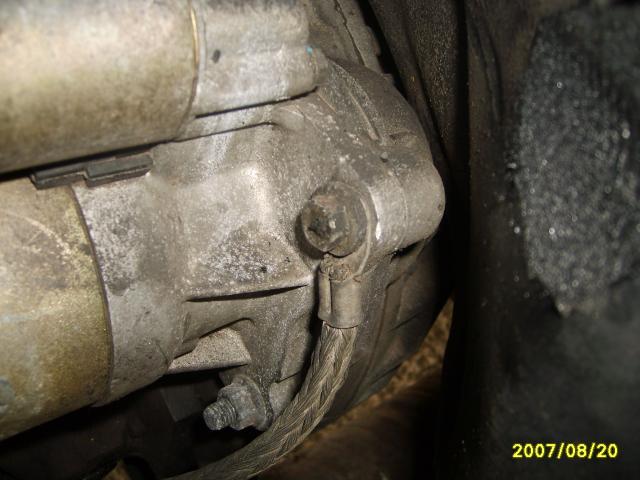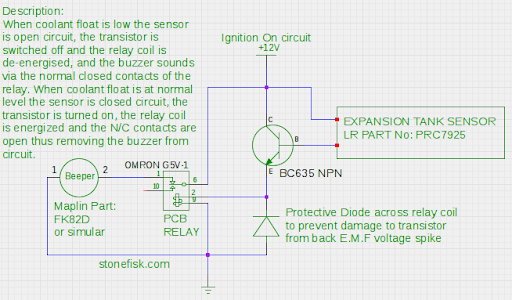-
Posts
999 -
Joined
-
Last visited
-
Days Won
5
Content Type
Profiles
Forums
Events
Gallery
Blogs
Posts posted by dailysleaze
-
-
it's in Harrods' window at the moment http://www.luxurious...harrods-london/
(til tomorrow)
-
I've only seen 3 pairs of galv 110 SW cappings on ebay this year. I bought one of them and paid £150 for the pleasure.
I feel your pain having been through the same conundrum myself. Although you may be in luck with these right now: http://www.ebay.co.u...=item3ccbb318cc
*Kicking myself*
There was a rumour that the puma ones were galvanised as standard?
-
There is one but i'm getting 9.9v when cranking on a fully charged brand new battery, so I want to give it the best route possible. Been reading this: http://forums.lr4x4.com/index.php?showtopic=68637
-
I want to fit an earth cable from the starter motor to the battery.
Anyone know how long it needs to be and what the stud size is on starter motor bolts below?

-
The light's also affected by the handbrake switch. You could check that + associated wiring.
-
-
The ones on the left are for a Discovery. I accidentally fitted them on my Defender but I can't really tell the difference.
-
They do look very intriguing...
-
Woo it works!
I went for option 2 in the OP, albeit I want to use the "Water in filter" warning light on the Td5 dash, which requires a switched earth, so I changed the relay to switch earth rather than ignition.
High coolant, switch is closed and relay energised, holding contacts away from warning light
Low coolant, switch is open and relay not energised, so contacts default to connecting the warning light
Break in the wire to the sensor, therefore relay not energised and failing safe
The PCB board came with a little black box, so I can house it behind the dash or somewhere
When the ignition goes on, there is a brief flash of the light as the relay energises
I'm so chuffed as i've never attempted anything electronic, but it worked first time!! All the credit really goes to that diagram on Stonefish. I just adapted it slightly to suit my requirements. Vehicle installation soon!
-
You don't even get door cards.
-
http://blogs.ec.europa.eu/ECintheUK/press-reports-on-ec-proposals-on-mot-tests-are-incorrect/
I love the quote "The Commission is writing separately to all the newspapers concerned, none of which checked the facts with us before publication."
-
-
I reckon I can get away with a transistor and a resistor to power an LED on the dash like in the Option 1 diagram in the OP.
As I understand it, relays are better than transistors for larger currents and other reasons below, but I don't think it matters that much. If the circuit has to power a buzzer or something requiring more juice, then a relay might be better. It might be that the high resistance in the reed switch means not enough current passes to energise a relay. Although, it might just be swings and roundabouts.
From here: http://www.kpsec.fre...om/trancirc.htm
"When to use a relay
Transistors cannot switch AC or high voltages (such as mains electricity) and they are not usually a good choice for switching large currents (> 5A). In these cases a relay will be needed, but note that a low power transistor may still be needed to switch the current for the relay's coil!
Advantages of relays:
- Relays can switch AC and DC, transistors can only switch DC.
- Relays can switch high voltages, transistors cannot.
- Relays are a better choice for switching large currents (> 5A).
- Relays can switch many contacts at once.
Disadvantages of relays:
- Relays are bulkier than transistors for switching small currents.
- Relays cannot switch rapidly, transistors can switch many times per second.
- Relays use more power due to the current flowing through their coil.
- Relays require more current than many ICs can provide, so a low power transistor may be needed to switch the current for the relay's coil."
- Relays can switch AC and DC, transistors can only switch DC.
-
I've been away for the last month, but i've just bought a load of components and am going down the route of trial and error. Will report back.
-
Cheers. I did see that one and I'm planning on using that warning lamp also. I was hoping though to try something simpler (no switches, test lights). What seems to be the key is that that solution requires an "interface module" from a guy that put them together for the difflock forum 3 years ago.
I'd like to get to the bottom of what's required to make something that works like the interface module, but with component parts.. if that's possible...

-
I've been doing a lot of research and there's lots of ways of installing the RR PRC7925 expansion cap into a Defender. Difflock, EP90, AULRO all have their own versions. I'm not electronically inclined and just want something simple to solder together but these guys talk about interface modules and other magic things...
The best in terms of simplicity i've found so far is from Stonefisk.com
Option 1

Option 2

These seem simple enough for me, but I don't know which is better? Why does one have a transistor and a resistor, but the other has a relay, transistor and diode? One talks about preventing voltage spikes to protect the components, etc.
My thought would be that having...
- a transistor (as a switch)
- a diode (preventing reverse current)
- a resistor (providing a route in event of coolant loss/failsafe)
...on one circuit would do the job?
Any thoughts?
- a transistor (as a switch)
-
-
Haha was hoping someone would give me a reason not to do it. The only problem is I'll have to do it on the road outside the house.
I was all set to swap the chassis this summer until I asked my parents if I could do it on their land (as I haven't the space). Dad said "why would you want to do that?". His point being that you could do a hell of a lot of welding for the cost of the chassis (including several rear cross members) and it wouldn't really add any value to the vehicle. It's cast doubt on it all for me. Unfortunately, I can't ignore the wiseness of my Dad...
I think in my case, the chassis (1997) is only just getting it's first hole. I can learn to weld on it. If it was shot to pieces and replacing the chassis was the only realistic option, then going galvanised would be a no-brainer. If the chassis is alright though, I don't think there's much reasoning for getting one other than wanting it (albeit a very powerful reason..
 )
) -
*In other words, start a job early sat morning (nursing hangover and/or having feed+watered children and animals as appropriate), realise at about 11.30 you need some odd-size nut, jump into other-half’s car and try to beat traffic to said supplier…
I've lost count how many times i've had to do this.
-
I think the flat face of the brackets also need to face forwards, as they bolt to the rear face of the heel board
-
I imagine this is the 300tdi van you have just bought sammyb? If it is I'd give it a good look over first, when I first got my 300tdi it wouldn't pull very well at all..... once I fixed the leaking manifold gasket, replaced the broken manifold studs and sorted the boost pipe to the injector pump it became a different beast. Anyway what I'm getting at is make sure it's running properly first then follow the tuning pdf that reb78 posted

On mine, I flushed the intercooler, removed the EGR, removed the cat and replaced the split manifold gasket. Afterwards it would pull hills in 3rd that beforehand needed 2nd. Quite impressed for these simple changes.
-
-
Could LR get the Defender price down by de-blinging them? I really fail to see why they should cost that much or is it that they don't cost that much it's just what LR perceive the market will stomach?
I think it's because they're hand-built with a UK labour force who are quite expensive = un-economical vehicle. I'd be interested to know how long it takes the factory to put one together.
I heard that if the Defender does carry on in it's current form then it'll be built in India
-
Further to this, the change to new fluid made both clutch cylinders leak, so I fitted new TRW master and slave cylinders. Anyway, the slave is now leaking again
Is there any reason for a new one to leak other than it being dodgy? All i can muster up is a deteriorating flexible pipe leaving bits in the fluid or the wrong push rod length so the slave over extends?









Calling anyone with a station wagon Puma, or Access to one!
in Defender Forum (1983 - 2016)
Posted
These people sell the modification off the shelf. Might give you something to go off if you don't want to fork out £160
http://www.ebay.co.uk/itm/Land-Rover-Defender-FWD-facing-Rear-Seat-MODIFICATION-/230871386855?pt=UK_CarsParts_Vehicles_CarParts_SM&hash=item35c101cae7&_uhb=1